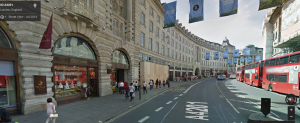
I was tasked with looking into Regent Street in London, which is mentioned in A Scandal in Bohemia. Here is the passage from the story that mentions Regent Street, and it entails Holmes describing Irene Adlers’ future husband:
“He was in the house about half an hour, and I could catch glimpses of him in the windows of the sitting-room, pacing up and down, talking excitedly, and waving his arms. Of her I could see nothing. Presently he emerged, looking even more flurried than before. As he stepped up to the cab, he pulled a gold watch from his pocket and looked at it earnestly, ‘Drive like the devil,’ he shouted, ‘first to Gross & Hankey’s in Regent Street, and then to the Church of St. Monica in the Edgeware Road. Half a guinea if you do it in twenty minutes!’
According to the Conan Doyle Encyclopedia, Gross & Hankey’s was probably a jewelry shop, although it was fictitious. Mr. Norton hurried there before going to the church to secure the wedding bands. After researching the Regent Street area, I focused on the section of the street that curves, heading into Piccadilly Circus. Today, this is a very upscale shopping district, and there is an Underground station at Piccadilly Circus. (Note: In this context, a circus, from the Latin word meaning “circle”, is a round open space at a street junction)



Although the jewelry shop was fictional, Booths’ map shows red and yellow which indicate the upper end of income. It can be established that the Regent Street/Piccadilly Circus area has been wealthy for over a century, at least.

Finally, British History Online provides an even deeper glimpse into the history of Regent Street. This website reinforced the facts that I already knew; the commercial aspects and the wealth of the area were well established. However, I also discovered when Regent Street was designed and built (1813), why it was named as it was, and the architect behind the buildings (John Nash).
The long vista of Regent Street, as seen from the Quadrant, is very fine, exhibiting, as it does, a remarkable variety of architectural features. It was erected principally from the designs of Mr. John Nash, who deserves to be remembered as the author of this great metropolitan improvement; and it was named from the architect’s patron, the PrinceRegent. The expenditure of the Office of Woods and Forests in its construction was a little in excess of a million and a half. Of course, being a thoroughfare of so recent a date, having been commenced in 1813, Regent Street has scarcely a back history for us to record here, like Pall Mall and St. James’s Street. It belongs to “new,” and not to “old” London.
In his design for Regent Street, Nash adopted the idea of uniting several dwellings into a façade, so as to preserve a degree of continuity essential to architectural importance; and it cannot be denied that he has produced a varied succession of architectural scenery, the effect of which is picturesque and imposing, superior to that of any other portion of the then existing metropolis, and far preferable to the naked brick walls at that time universally forming the sides of our streets.
Read the explanation of Regent Street help better imagination that way different since first time read it at A Scandal of Bohemia. http://telkomuniversity.ac.id